November, autumn and winter alternate. Will it be very cold this winter?
November, originally the season of alternating autumn and winter, was driven out by the cold and strong this year. Before enjoying her elegance, people have put on long trousers and put on warm babies to experience the chill brought by La Nina, a "little girl", in the strong wind.
November weather keywords
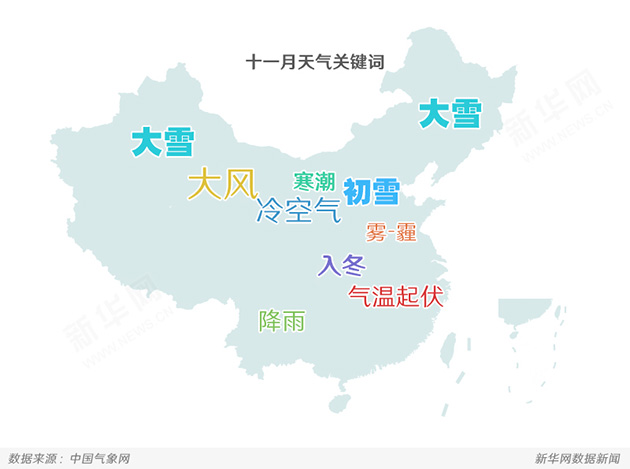
Crying before winter, it turned out that La Nina was making trouble.
The temperature dropped suddenly, and there was more precipitation. "It’s so cold! It’s so cold! " It has become the mantra of people in the north of the Yangtze River recently. However, all this has something to do with La Nina phenomenon. The original meaning of La Nina is "little girl", also known as "anti-El Nino", which is generally judged by the SST anomaly index in Nino3.4 area (the equatorial Pacific between 120 and 170 west longitude and 5 south latitude). When the sea surface temperature anomaly in this area is below minus 0.5℃, it is called "La Nina state". If the "La Nina state" lasts for more than 5 months, it is judged as a "La Nina event".
In August 2016, the SST anomaly index in the equatorial Middle East Pacific reached-0.53℃, indicating that it has officially entered the "La Nina state".
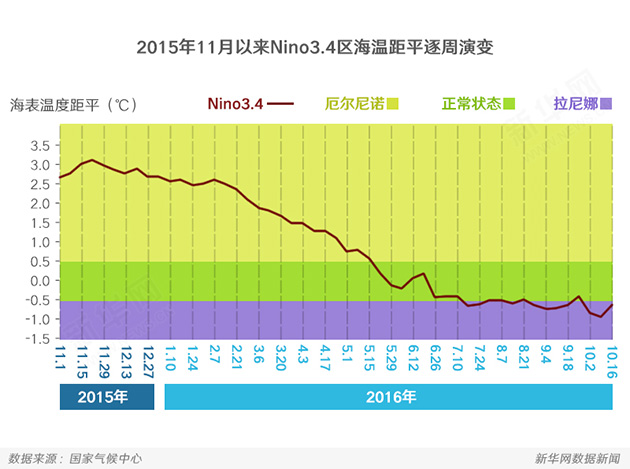
"La Ni? a Event" will lead to low winter temperatures in most parts of China. From the average annual temperature anomalies in China in the past 13 La Ni? a years, it can be seen that the winter temperatures in most La Ni? a years are cold. For example, the "La Nina Event" in 2000 caused the temperature in Northeast China and North China to be obviously low in winter from 2000 to 2001. Remember the widespread low temperature, rain and snow freezing in the south in early 2008? That’s La Nina’s fault.
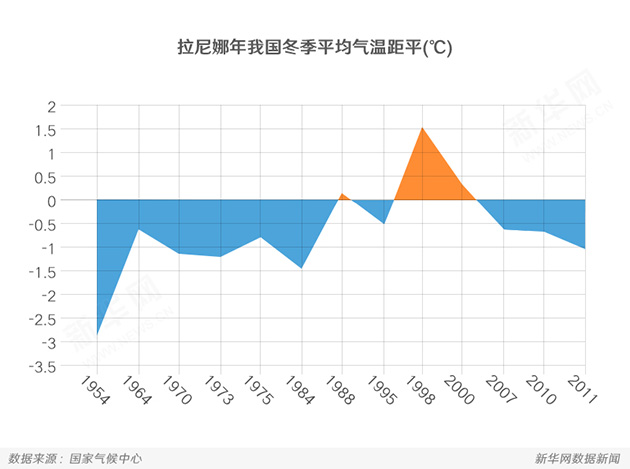
However, in the winter of 1998-1999, when the El Ni? o turned to La Ni? a, the temperature in most parts of China was obviously high, mainly because the climate warming rate in China was very fast in the 1980s and 1990s, and 1998 was another El Ni? o year, so the whole atmosphere was warming very fast, so in winter, the warm background caused by global warming and El Ni? o did not fade, and the cooling caused by La Ni? a was much smaller than that in the big climate background, so that.
Therefore, from the historical statistics, it is not surprising that there has been a cold winter this year. According to the prediction of climate experts, this winter, due to the influence of La Nina, China will be cold on the whole, but the cold is not national, and there is a great difference between the north and the south. Comparatively speaking, the degree of cold in the north of China is more obvious, and it will be cold in areas that continue to be warm.
Is it winter in your place?
Folk custom takes "beginning of winter" as the beginning of winter. In fact, China has a vast territory. Except for the coastal areas of South China where there is no winter all year round and the Qinghai-Tibet Plateau where there is no summer in long winter, the winters do not start at the same time. According to the standard of dividing four seasons in climatology, the first day when the average temperature drops below 10℃ for five consecutive days in the second half of the year is the beginning of winter.
According to this standard, the average winter time of nearly half the provincial capital cities in China is in November. Mohe in the northernmost part of the country and the area north of Daxinganling took the lead in entering the long winter in early September; In the first half of October, some areas in the northwest and northeast successively entered the threshold of winter; Beijing was already a scene of winter in late October; In November, the Yangtze River basin in the south gradually entered the winter; At the beginning of December, winter approached Wuyi Mountain Range and the northern slope of Nanling Mountain in the north of Guangdong and Guangxi.
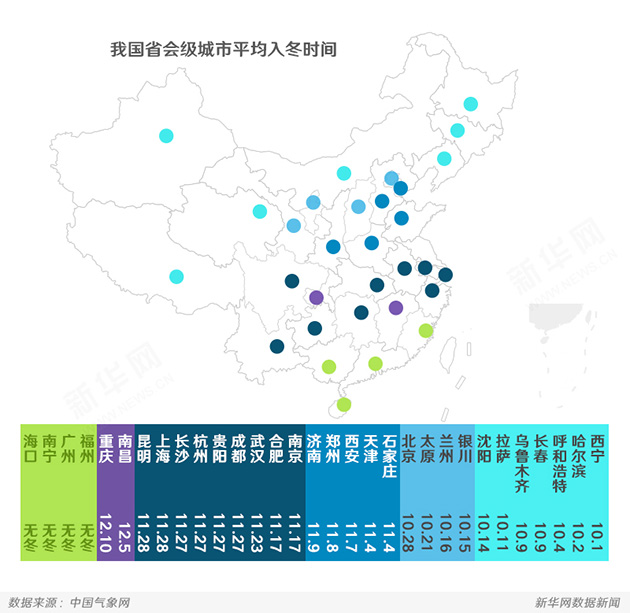
According to this standard, winter should be the longest season in most parts of northern China. Among provincial-level cities, there are seven cities with winter length accounting for more than half of the whole year, among which Xining and Harbin have the longest average winter time, reaching 207 days, accounting for 56.7% of the whole year.
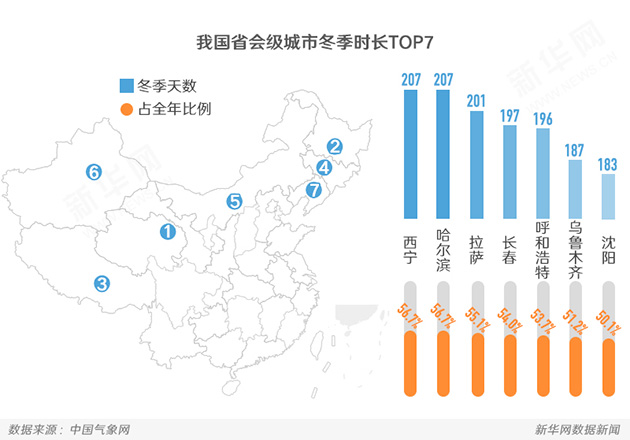
The first snow in 2016 came earlier!
In winter, the first snow is a major event with wide influence. As the saying goes, "Ruixue is a good year" is definitely a good sign for farmers who grow winter wheat in the north; However, in vegetable planting areas in the south and pastoral areas in the north, the arrival of the first snow means freezing injury and the reduction of forage. It has become the habit of farmers and herdsmen to take corresponding defensive measures in time according to the date of the first snow. In addition, people in transportation, electric power, medical care, sanitation, heating operation and other industries are also concerned about when the first snow will come.
According to historical data, we can calculate the average time of first snow falling in major cities. Since October, with the continuous drop of temperature, the precipitation pattern in China from north to south has gradually changed from rain to snow. Judging from the time when the first snow appears in provincial capital cities all the year round, the first snow is concentrated from mid-October to January of the following year. In November, seven cities will see the first snow, and December is the most concentrated month.
This year, influenced by strong cold air, on October 27th, Hohhot, Lanzhou and Yinchuan ushered in the first snowfall of this year, which was earlier than the average time of the first snowfall all the year round. This time, the cold air dragged the northern friends directly from the early autumn to the middle of winter, which was really the rhythm of cold crying. At present, cold air will be more frequent in November, so everyone should be mentally prepared.
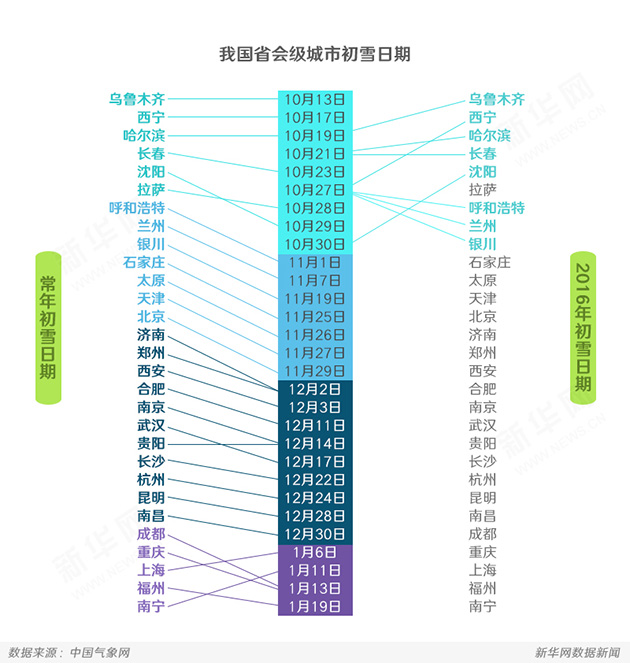
Cold air is also divided into three, six, nine and so on?
After entering the autumn and winter festivals, cold air frequently goes south. Although the temperature in all parts of the country shows a downward trend, the cold air encountered in different regions and different periods is definitely not a level! According to the degree of strength, cold air in China is divided into five grades: weak cold air, medium-intensity cold air, strong cold air, strong cold air and cold wave.
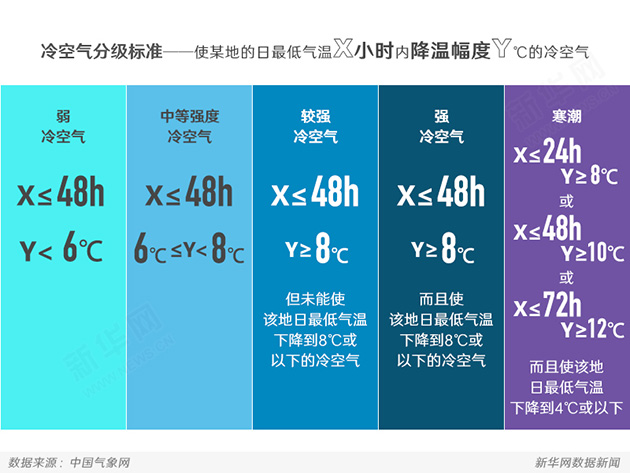
"Seven Types of Self-protection" in Strong Wind Cooling
With the arrival of cold air, respiratory diseases are also on the rise. At present, respiratory diseases in hospital outpatients have an increasing trend compared with the same period of last year. Experts suggest that you can take drugs to prevent colds properly, such as Radix Isatidis, or drink more hot water, and you can also take measures to prevent colds such as scraping and cupping, especially soaking your feet with traditional Chinese medicine.
In addition, when the strong wind strikes, you can refer to the following "seven types of self-protection" to spend the winter safely:
The first type: the mask is added to keep warm and prevent diseases.
The nose and mouth are the gateway to the respiratory tract. Mask is an indispensable cold-proof tool, which can effectively prevent dust, floating and sinking from invading the skin, and can also prevent it from being hurt by the cold wind.
Type 2: Wash your face with warm water and drink more hot water.
Wash your face at 20-37℃, and choose skin care products with good moisturizing effect.
Drink more hot water, the amount of water you drink every day varies from person to person, but "drink more hot water" is by no means perfunctory when the wind cools down.
The third type: wear knee pads to protect joints.
Many people will feel joint pain in windy weather. Especially when traveling by bike, you may wish to wear knee pads and wrist pads to protect your joints.
The fourth type: open the window for air to adjust the temperature difference.
Excessive temperature difference between indoor and outdoor can also lead to high incidence of diseases. Depending on the air outside, you can open the window for ventilation twice a day for about 30 minutes each time.
The fifth type: if a foreign object enters your eyes, don’t rub it when you blink.
Windy weather can easily lead to foreign bodies entering the eyes. It is suggested to blink more to promote the secretion of tears and discharge them, so as to avoid rubbing hard to scratch the cornea or embed foreign bodies into the cornea, thus causing infection and inflammation.
Type 6: cardiovascular disease, go out as little as possible.
The sudden drop of temperature is easy to induce diseases such as stroke, cerebral infarction and myocardial infarction. In addition to keeping warm, patients with cardiovascular and cerebrovascular diseases should try not to go out in windy days. If they have to go out, it is best to take some quick-acting pills, nitroglycerin and other drugs after 10 o’clock.
The seventh type: dress moderately and enhance immunity.
Under the premise of ensuring that the body is not cold, it is not appropriate to cover it too strictly, but sweating will reduce immunity.
Xinhuanet link:http://news.xinhuanet.com/video/sjxw/2016-11/02/c_129347110.htm
Xinhuanet Data News Department China Meteorological Network jointly produced.
Source: China Meteorological Network, National Climate Center, China Weather Network and Yangguang Network.